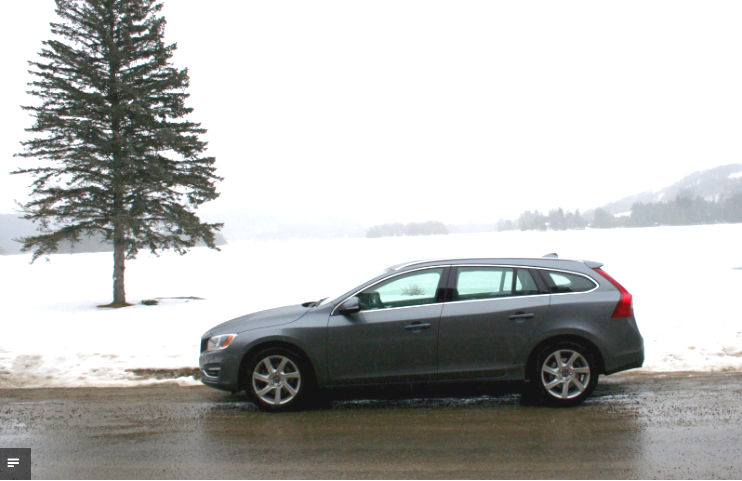Long-Term Test: 2016 Volvo V60 Sportwagon – Part 2

Story and photo by John LeBlanc
Before being replaced by minivans, crossovers and SUVs, station wagons were the utility vehicles of their time — a long time ago, on new car dealer lots far, far away. That’s why we decided it only made sense as part of our tenure with our 2016 Volvo V60 Sportwagon long-term tester to evaluate the Swedish wagon as a utility vehicle for our family’s annual March school break ski getaway.
While you may assume Volvo’s always offered station wagons since the first examples arrived after World War II, the 2015 Canadian debut of the V60 Sportwagon — the wagon variant of the brand’s existing S60 four-door sedan — filled a hole in the automaker’s lineup left by the departure of the smaller V50 and larger V70 wagons (albeit, the SUV-like XC70 still remains).
With optional all-wheel drive, room for five passengers and the promise of more cargo room in its swoopy rear space, we were looking forward to using our Volvo V60 Sportwagon T6 Drive-E AWD Premier ($55,850) to transport the three of us and our ski gear for a few days of winter fun at Quebec’s Mont Tremblant area.
Despite a relatively mild winter, we still needed to pack clothes preparing for typical, late-Canadian winter temperature swings, including either wet and cold weather — or both. Yet even with our puffy jackets on, the compact Volvo was a comfortable ride for the just-under two-hour drive from our home base in Ottawa, Ont., to our lodging at Lac Ouimet, Quebec, only a few kilometres outside the Tremblant ski centre.
As we discovered in our first installment, Volvo’s ongoing development of the front- or all-wheel-drive V60 Sportwagon — on sale in foreign markets since 2010 and starting at $40,600 — has resulted in higher levels of refinement that are on par or better than European sport wagon rivals like the Audi A4 Allroad Quattro ($43,200) and BMW 3 Series xDrive Touring ($47,850). And halfway through our two-month test drive, we’ve been particularly happy with the Volvo cabin’s quality and ambience.
The V60 Sportwagon’s stylish interior offers a respite from the more formal German styles. Our wagon’s floating centre console and so-called Sensus central digital screen are now Volvo standards, plus the digital dash that houses the customizable instrumentation in front of the driver offers stunningly crisp graphics.
Like its Volvo S60 sedan sibling, the V60 Sportswagon’s heated three-spoke steering wheel is thick and great to hold. Larger bodies may find themselves tight for elbow space; however, the wagon’s heated front seats are supportive and some of the most comfortable in any car we’ve recently driven.
For our ski getaway, we only had our pre-teen daughter in the Volvo’s second-row seating. And while Volvo has done a good job not letting the V60 Sportwagon’s sloping rear roof section impede on rear passenger headroom, in a couple of years, we could see her asking for more leg space.
And when it came to assessing the space behind those rear seats, one look at the V60’s rear styling and it’s obvious Volvo designers took a different approach than the box-they-were-shipped-in Swedish wagons from the past, from the 145 to the last V70.
Although not as roomy as its Audi and BMW competition, the V60 Sportwagon’s rear cargo space is quite flexible. With 1,240 litres of rear cargo space, the wagon offers almost four times the room over its S60 sedan sibling, and the low lift over height is a feature no tall-riding crossover can offer.
Dropping the middle section of the V60’s 40/20/40 split rear seating was just the trick to handle longer objects like skis and snowshoes and still have room for two passengers. Even with all our luggage and gear, we were able to secure the wagon’s rear tonneau cover to keep all of our flotsam and jetsam in place. And while Henry, our Havanese, had plenty of space, larger breed dog owners will appreciate the Volvo’s roll-up dog security net.
And, of course, if we were to keep a V60 Sportwagon beyond the 60 days of our test, a rooftop carrier could easily deal with any of our additional cargo hauling needs.
As much as Volvo believes in the wagon form as practical family transportation, the Swedish automaker knows its V60 Sportwagon won’t kill off its more popular crossover models, like the XC60 that shares the same platform. Instead, the V60 (and the larger, forthcoming V90) is there for former Volvo wagon owners who want the driving attributes of a sedan but with a little more cargo space.
As a family hauler, the Volvo ends up as a stylish vehicle that gives up some of the practicality traditionally associated with boxier Volvo wagons from the past in an effort to compete with rivals from BMW and Audi. And, in the end, we think our long-term 2016 Volvo V60 Sportwagon makes a fantastic anti-SUV statement for not only winter getaways, but everyday use as well.





![[del.icio.us]](https://www.straight-six.com/wp-content/plugins/bookmarkify/delicious.png)
![[Digg]](https://www.straight-six.com/wp-content/plugins/bookmarkify/digg.png)
![[Facebook]](https://www.straight-six.com/wp-content/plugins/bookmarkify/facebook.png)
![[Google]](https://www.straight-six.com/wp-content/plugins/bookmarkify/google.png)
![[Reddit]](https://www.straight-six.com/wp-content/plugins/bookmarkify/reddit.png)
![[StumbleUpon]](https://www.straight-six.com/wp-content/plugins/bookmarkify/stumbleupon.png)
![[Twitter]](https://www.straight-six.com/wp-content/plugins/bookmarkify/twitter.png)
![[Email]](https://www.straight-six.com/wp-content/plugins/bookmarkify/email.png)